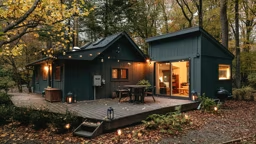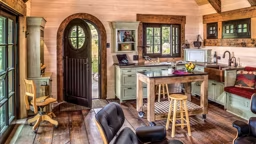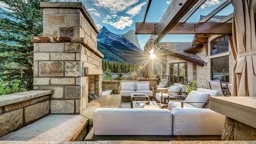Patios are both an extension of a cabin and a place apart, a spot to stay outdoors that much longer, but within reach of the cabin’s comforts. Colors and materials can echo or contrast the rustic feeling of your getaway: A less uniform choice like chunks of granite complement close-by natural elements like trees, water and beaches, while a more ordered choice like brick can lend a little bit of civilization at the end of a day. A patio is the perfect patch on which to linger as the sun goes down, dine from paper plates, share the bottle of wine you’ve been saving, or bring out the old Yahtzee game.
Design: Ginkgo Leaf Studio, www.ginkgoleafstudio.net
Lakeside
Ginkgo Leaf Studio, a landscape design firm, wanted to make the most of this home’s position on a small spring-fed lake in Glendale, Wis. So, the dining area was pushed as close to the water as it could go. “We wanted them to feel like they were on the water when they were eating,” says design principal James M. Drzewiecki, Assoc. AIA. For that, a granite retaining wall was built and an aircraft-cable fence was put up for safety. “It’s a good 5-foot drop to the beach below,” he adds. The patio is bluestone and brick. Design: Ginkgo Leaf Studio, www.ginkgoleafstudio.net
Design: Ginkgo Leaf Studio, www.ginkgoleafstudio.net
Southwest feeling
For this patio, the owners wanted something that would reflect their passion for Southwestern art, but also fit in southeastern Wisconsin where their place is located. Ginkgo Leaf Studio, a landscape design firm, used a color palette and details that bring to mind the Southwest without resorting to what design principal James M. Drzewiecki calls a “Disney-fied” version of it. That meant choosing colors mindfully and bringing in plants native to the Midwest. “There are no yucca,” he says. “The pergola has much heavier beams than we usually use, stained a dark chocolate brown, to make it stand out and give it a nod to the contemporary.” The patio is acid-stained concrete.
Design: 450 Architects, Inc., www.450architects.com
Planning ahead
This Sonoma County, Calif., patio benefits from redwoods that provide shade and protect against cold winds and rain. The patio is laid out with “Yosemite slate” flagstone in a random pattern, set over crushed granite. A geotextile fabric underneath keeps weeds out without using chemicals. “The exterior and interi-or spaces are designed to work in concert,” says Richard Lee Parker, AIA, LEED AP BD+C, principal at 450 Architects. “This is ideal for Sonoma’s Mediterranean climate; it couldn’t be detailed this way for Tahoe or a place that gets snow.”
Design: Matthew Cunningham Landscape Design LLC, www.matthew-cunningham.com
Restoration
For this property on Maine’s Mount Desert Island near Acadia National Park, Matthew Cunningham Landscape Design used reclaimed granite varying from 6 to 18 inches thick set in compacted crushed stone. The site, which had been battered by devastating storms for many years, required extensive stormwater management. The firm employed the stone and native plants to both enhance drainage and create a balanced, natural feel. Lichen-encrusted stone retaining walls and thick slabs of salvaged granite for the terraces and pathways echo each other and provide a sense of nature and order.
Design: TG&R Landscape Group, www.tgrlandscape.com
Creating a room
A well-designed outdoor space is like a room inside a cabin: a place to read, relax or eat, but with the advantages of the outdoors that cabins and cottages are built for. This patio located near Charlotte, N.C., uses a pergola to set apart the dining area and it lends a little sense of order in a space nestled in the woods. A brick fire pit and the pergola’s column bases have natural-stone caps. TG&R Landscape Group used permeable Belgard Subterra environmental pavers for the terrace, which reflects the home’s architecture so the patio feels original to the overall design and not like an addition.
Daphne Howland is a freelance writer based in Portland, Maine, where she can work on the patio, but prefers to just relax there.















